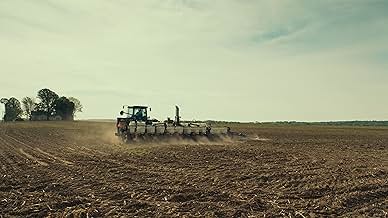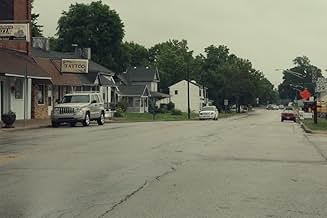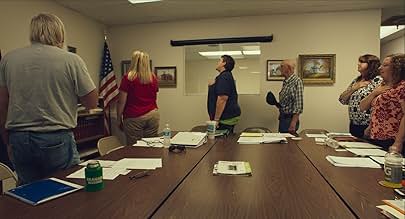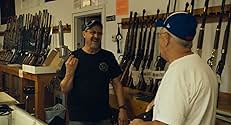Adicionar um enredo no seu idiomaFollowing the 2016 presidential election, Frederick Wiseman's documentary dissects small-town America to understand how its values impact and influence the political landscape of the nation.Following the 2016 presidential election, Frederick Wiseman's documentary dissects small-town America to understand how its values impact and influence the political landscape of the nation.Following the 2016 presidential election, Frederick Wiseman's documentary dissects small-town America to understand how its values impact and influence the political landscape of the nation.
- Direção
- Prêmios
- 1 vitória e 4 indicações no total
Avaliações em destaque
Very weird seeing a documentary about a small town 15 minutes from where I live, and that I've spent a decent chunk of time in. Seeing it from an outsider's perspective was different, and seeing all of these roads I've driven on through a camera lens was an odd experience. Honestly surprised the director found enough content in Monrovia to make an almost two and a half hour movie out of, considering I can drive across town in twenty seconds. Still cool, though, never knew this documentary existed. I always like documentaries that show an unfiltered glimpse into the life of others, and this was no different, even though the life it showed was basically the same as the one I live.
The film Monrovia Indiana is a truly remarkable achievement in that just when you think it cannot possible go on any longer, it just keeps going, much like the Great Crossroads itself. This is a shame.
Contrast with Hale County. That film too turned the camera on an overlooked slice of America, and yet it transcended the typical narrative to reveal something more, something unexpected. A conversation with a man burning leaves turned into the sublime. It provided space for you to think and reflect. Mr. Weisman on the other hand seems to believe that shots of coke in the supermarket are quite subversive, and that it is dreadfully important that viewers experience a full length Masonic ceremony, stumbling and stammering and all. Even Gopher Prairie is a more flattering portrait of small town America than this.
Oh and here's a shot of a field. Wow that sure is a field! And oh here's a shot of a building. That's sure some building there! It all literally looks like google street view.
And oh and now they've been talking about a bench for five minutes. And now a dog is getting its tail amputated for who knows why. And now we are at the mattress store. And now we're in church. Just kill me now.
I refuse to believe that America can possibly be as dull, as small, and as ugly as it is presented as here. There is no profound insight in debating a bench! There is nothing to reveal in a mattress warranty! This is not art but a caricature that has the gall to try passing itself off as an auteur's quietly documentary of real America.
In short: this is a film we've all seen before and do not ever need to see again. It's amazingly boring both visually and narratively, and conceptually bankrupt. The best that can be said of this self indulgent mess is that it quickly and unknowingly descends into self parody.
Contrast with Hale County. That film too turned the camera on an overlooked slice of America, and yet it transcended the typical narrative to reveal something more, something unexpected. A conversation with a man burning leaves turned into the sublime. It provided space for you to think and reflect. Mr. Weisman on the other hand seems to believe that shots of coke in the supermarket are quite subversive, and that it is dreadfully important that viewers experience a full length Masonic ceremony, stumbling and stammering and all. Even Gopher Prairie is a more flattering portrait of small town America than this.
Oh and here's a shot of a field. Wow that sure is a field! And oh here's a shot of a building. That's sure some building there! It all literally looks like google street view.
And oh and now they've been talking about a bench for five minutes. And now a dog is getting its tail amputated for who knows why. And now we are at the mattress store. And now we're in church. Just kill me now.
I refuse to believe that America can possibly be as dull, as small, and as ugly as it is presented as here. There is no profound insight in debating a bench! There is nothing to reveal in a mattress warranty! This is not art but a caricature that has the gall to try passing itself off as an auteur's quietly documentary of real America.
In short: this is a film we've all seen before and do not ever need to see again. It's amazingly boring both visually and narratively, and conceptually bankrupt. The best that can be said of this self indulgent mess is that it quickly and unknowingly descends into self parody.
In my opinion, Frederick Wiseman is the greatest documentary film maker of all time and here he looks at life in Monrovia, Indiana a small town farming community.
As in other Wiseman films, there is no narration, interviews or leading questions. He simply allows us to get a glimpse into the lives of people living here. He starts off with some beautiful shots of blue skies, breezes blowing through the trees and fields. Then we see towns folk going about their business in their jobs and everyday life. Only Wiseman could make working in a pizzeria or a supermarket seem fascinating. The early scenes shows the Monrovia High School, showing a teacher proudly talking about Indiana basketball players, there is also a quick scene of students rehearsing a musical revue. There is no scenes of any trouble at the school, unlike Wiseman's 1968 classic "High School". One of the funnier moments is a group of older men at a diner talking about diet food and drinking a lot of beer to get it down. We see a pig farmer getting his pigs ready to be sold. Wiseman spares us from seeing them slaughtered which I thought was unusual for him since he normally shows us everything. However later on, we get to see a veterinarian operating on a dog's tail reminiscent of the operation we got to see in Wiseman's 1993 "Zoo". There are a few long sequences of the town council discussing new houses being built and lack of fire hydrant inspections. A wedding is shown in a Christian church with nice singing of the old song "Always". There is a scene in a gun shop where owner and customer talk about rifle scopes for deer hunting and about a friend with gall stones. The final sequence is the funeral of a beloved wife and mother. Wiseman is always great at giving a well rounded picture of his subjects. The last scene of the coffin being lowered is very moving. It is often the last scene of a Wiseman film that hits you the hardest, and that is what happens here.
While this is not one of Wiseman's best, it still is a worthy addition to his collection.
As in other Wiseman films, there is no narration, interviews or leading questions. He simply allows us to get a glimpse into the lives of people living here. He starts off with some beautiful shots of blue skies, breezes blowing through the trees and fields. Then we see towns folk going about their business in their jobs and everyday life. Only Wiseman could make working in a pizzeria or a supermarket seem fascinating. The early scenes shows the Monrovia High School, showing a teacher proudly talking about Indiana basketball players, there is also a quick scene of students rehearsing a musical revue. There is no scenes of any trouble at the school, unlike Wiseman's 1968 classic "High School". One of the funnier moments is a group of older men at a diner talking about diet food and drinking a lot of beer to get it down. We see a pig farmer getting his pigs ready to be sold. Wiseman spares us from seeing them slaughtered which I thought was unusual for him since he normally shows us everything. However later on, we get to see a veterinarian operating on a dog's tail reminiscent of the operation we got to see in Wiseman's 1993 "Zoo". There are a few long sequences of the town council discussing new houses being built and lack of fire hydrant inspections. A wedding is shown in a Christian church with nice singing of the old song "Always". There is a scene in a gun shop where owner and customer talk about rifle scopes for deer hunting and about a friend with gall stones. The final sequence is the funeral of a beloved wife and mother. Wiseman is always great at giving a well rounded picture of his subjects. The last scene of the coffin being lowered is very moving. It is often the last scene of a Wiseman film that hits you the hardest, and that is what happens here.
While this is not one of Wiseman's best, it still is a worthy addition to his collection.
The director captured the essence of Indiana small-town life perfectly in this PBS documentary. The citizens of Monrovia are exactly the same personality types that I met during my time in rural Indiana about 40 years ago. It appears that nothing has changed.
I lived in Clayton, Indiana for about 4 years. Clayton is very close to Monrovia, which had the only bank in the area. I came from the Seattle, WA area, so the whole culture and landscape of Clayton and Monrovia were foreign to me - the flat fields as far as the eye could see and beyond. The social life of people in these farm areas is very structured and life experiences are limited by the narrow perspective of a strictly proscribed culture. I ended up in Indiana because my husband and I wanted to established a thoroughbred stud farm and his parents had a large parcel of land. When we got there and realized what a different landscape and social structure we found ourselves, I regretted moving there almost immediately. I was in a strange place and I had a lot to learn about middle America culture. People knew that I was not local. Not just from my (non-Southern) accent, but from my questions about (1) the religious emphasis in daily life, l(2) seeming lack of interest in local or national government, and (3) attitudes about women and their "place" in society.
After returning to the Pacific Northwest after 4 years and Iooking back on my experiences in Clayton and Monrovia, I had a better idea about how people in different parts of America think about life and society in general. Where we live molds our perspective through exposure to different people and different landscapes.
I lived in Clayton, Indiana for about 4 years. Clayton is very close to Monrovia, which had the only bank in the area. I came from the Seattle, WA area, so the whole culture and landscape of Clayton and Monrovia were foreign to me - the flat fields as far as the eye could see and beyond. The social life of people in these farm areas is very structured and life experiences are limited by the narrow perspective of a strictly proscribed culture. I ended up in Indiana because my husband and I wanted to established a thoroughbred stud farm and his parents had a large parcel of land. When we got there and realized what a different landscape and social structure we found ourselves, I regretted moving there almost immediately. I was in a strange place and I had a lot to learn about middle America culture. People knew that I was not local. Not just from my (non-Southern) accent, but from my questions about (1) the religious emphasis in daily life, l(2) seeming lack of interest in local or national government, and (3) attitudes about women and their "place" in society.
After returning to the Pacific Northwest after 4 years and Iooking back on my experiences in Clayton and Monrovia, I had a better idea about how people in different parts of America think about life and society in general. Where we live molds our perspective through exposure to different people and different landscapes.
The documentary was cute and artsy but continues on for so long without much direction. Were it to delve more into some specifics of personal life in much less time, it may be more interesting, but the amount of time where absolutely nothing consequential is going on in the movie is mind numbing.
Você sabia?
- CuriosidadesShot in ten weeks.
Principais escolhas
Faça login para avaliar e ver a lista de recomendações personalizadas
Detalhes
Bilheteria
- Faturamento bruto nos EUA e Canadá
- US$ 63.944
- Fim de semana de estreia nos EUA e Canadá
- US$ 5.172
- 28 de out. de 2018
- Faturamento bruto mundial
- US$ 64.596
- Tempo de duração2 horas 23 minutos
- Cor
- Proporção
- 1.85 : 1
Contribua para esta página
Sugerir uma alteração ou adicionar conteúdo ausente









